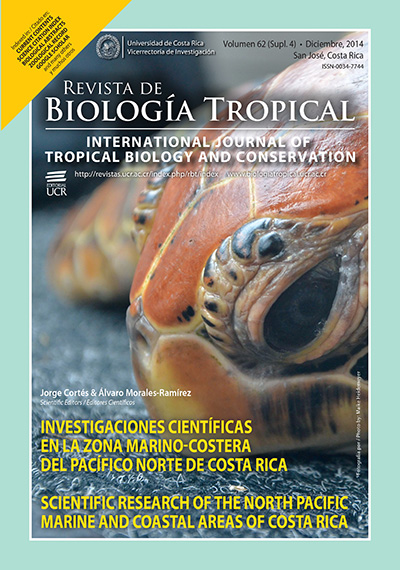Abstract
Characterization of the Mid Summer Drought in two Pacific slope river basins of Costa Rica, Central America. The Eastern Tropical Pacific region is characterized by climate features rarely observed in tropical regions, one of them is the Mid-Summer Drought (MSD), “veranillo” or “canícula” in Spanish. On the Pacific slope of Central America, the annual precipitation cycle is characterized by two rainfall maxima in June and September-October, an extended dry season from November to May, and a shorter reduced precipitation period during July–August (MSD), during July, the magnitude of the trade winds increases and this is associated also with the Caribbean Low Level Jet (CLLJ), but characterization of these features using monthly data is difficult. In this work, seven daily gauge stations records, located at two important river basins of Costa Rica, Tarcoles and Tempisque, were studied to characterize the MSD from 1937 to 2012. Among the aspects considered are the MSD Start, Timing, End, Duration, Intensity and Magnitude. The modulation and seasonal predictability of these aspects by climate variability sources as Equatorial Eastern Pacific was lately explored, showing that warmer (cooler) conditions in Niño 3.4 tend to be associated to drier (wetter) MSD events. Rev. Biol. Trop. 62 (Suppl. 4): 1-15. Epub 2014 Diciembre 01.
References
Alfaro, E.J., Soley, F.J. & Enfield, D. (2003). Uso de una Tabla de Contingencia para Aplicaciones Climáticas (Use of a Contingency Table for Climatic Applications). Guayaquil, Ecuador: ESPOL-FUNDESPOL.
Alfaro, E.J. & Soley, F.J. (2009). Descripción de dos métodos de rellenado de datos ausentes en series de tiempo meteorológicas. Rev. Mate.: Teor. Aplic.,16, 59-74.
Alfaro, R., Fernández, W. & Connell, B. (1999). Detection of the forest fires of April 1997 in Guanacaste, Costa Rica, using GOES-8 images. Int. J. Remote Sensing, 20, 1189-1195.
Amador, J. (2008). The Intra-Americas Seas Low-Level Jet (IALLJ): Overview and future research. Ann. N.Y. Acad. Sci., 1146, 153-188.
Amador, J.A., Alfaro, E.J., Lizano, O.G. & Magaña, V.O. (2006). Atmospheric forcing in the Eastern Tropical Pacific: A review. Progr. Oceanogr., 69, 101-142.
Echeverría-Bonilla, J. (2004). Estudio de caso cuenca Tempisque, Costa Rica. Informe técnico. Estrategia para la Gestión Integrada de los Recursos Hídricos en Costa Rica. Plan Nacional de Gestión Integrada del Recurso Hídrico. San José, Costa Rica: Ministerio del Ambiente y Energía. (Consultado: 01 de julio de 2013, http://www.drh.go.cr/textos/estrategia/)
Espinoza, C.E. & Villalta, R.A. (2004). Estudio de caso sobre la contaminación de la cuenca de los ríos virilla y grande de tárcoles (cuenca 24). Documento técnico. Estrategia para la Gestión Integrada de los Recursos Hídricos en Costa Rica. Plan Nacional de Gestión Integrada del Recurso Hídrico. San José, Costa Rica: Ministerio del Ambiente y Energía. (Consultado: 01 de julio de 2013, http://www.drh.go.cr/textos/estrategia/)
INEC (2012). X censo nacional de población y VI de vivienda 2011: Características sociales y demográficas. Tomo I. San José, Costa Rica: Instituto Nacional de Estadística y Censos.
Karnauskas, K.B., Giannini, A., Seager, R. & Busalacchi, A.J. (2013). A simple mechanism for the climatological midsummer drought along the Pacific coast of Central America. Atmósfera, 26, 261–281.
Magaña, V.O., Amador, J.A. & Medina, S. (1999). The midsummer drought over Mexico and Central America. J. Clim., 12, 1577-1588.
Moreno-Díaz, M.L., Choden, S., Floquet, A. & Mongbo, R.L. (2011). Protected Areas - not just for biodiversity Conservation: The contributions of protected areas to the economic and social development in Bhutan, Costa Rica and Benin. Heredia, Costa Rica: UNA, CINPE, CEBEDES, NCD, Zeta Servicios Gráficos S.A.
Nakaegawa, T., Kitoh, A., Ishizaki, Y., Kusunoki, S. & Murakami, H. (2013). Caribbean low-level jets and accompanying moisture fluxes in a global warming climate projected with CMIP3 multi-model ensemble and fine-mesh atmospheric general circulation models. Int. J. Climatol., doi: 10.1002/joc.3733.
Ramírez, P. (1983). Estudio Meteorológico de los Veranillos en Costa Rica. Informe Técnico. Nota de investigación No 5. San José, Costa Rica: Instituto Meteorológico Nacional, Ministerio de Agricultura y Ganadería.
Soley, F.J. (1994). Suavizamiento de series cronológicas geofísicas con ruido blanco y rojo aditivo. Rev. Geofís., 41, 33-58.
Taylor, M. A., Enfield, D. B. & Chen, A. A. (2002). Influence of the tropical Atlantic versus the tropical Pacific on Caribbean rainfall, J. Geophys. Res., 107, doi:10.1029/2001JC001097.
Wang, C. & Enfield, D. B. (2003). A further study of the tropical western hemisphere warm pool. J. Clim., 16, 1476–1493.
Wilks, D. (2006). Statistical Methods in the Atmospheric Sciences (2da. ed.). San Diego, California: Academic.
##plugins.facebook.comentarios##

This work is licensed under a Creative Commons Attribution 4.0 International License.
Copyright (c) 2015 Revista de Biología Tropical


